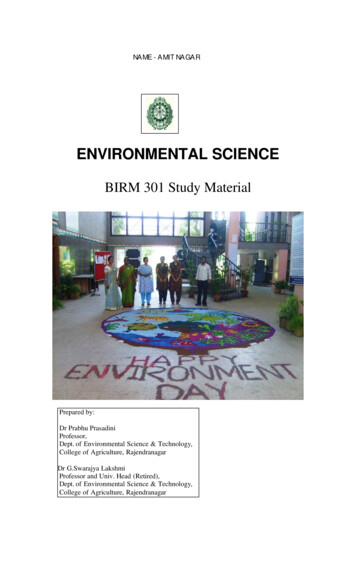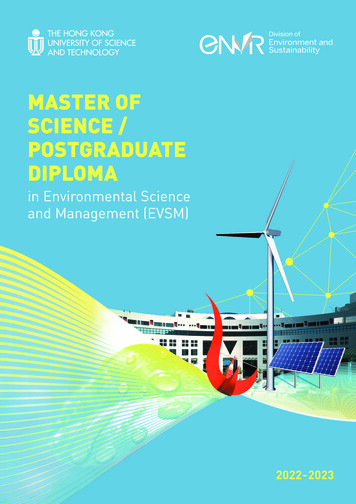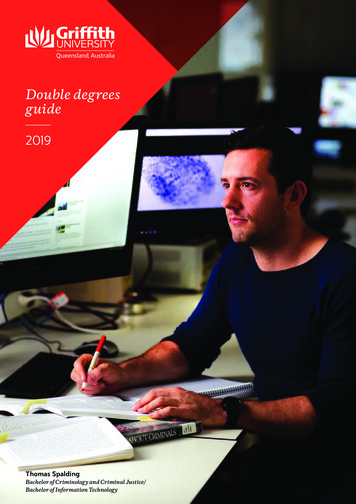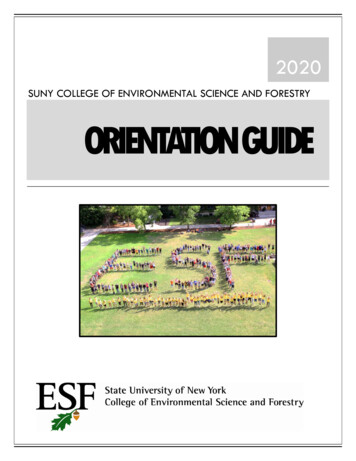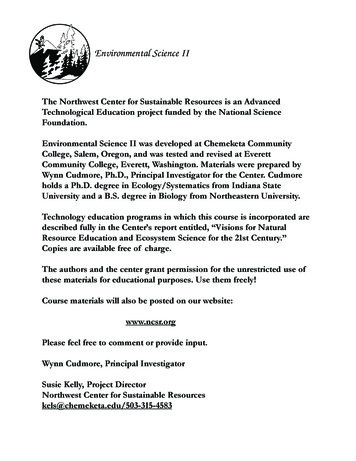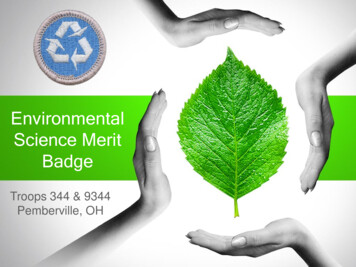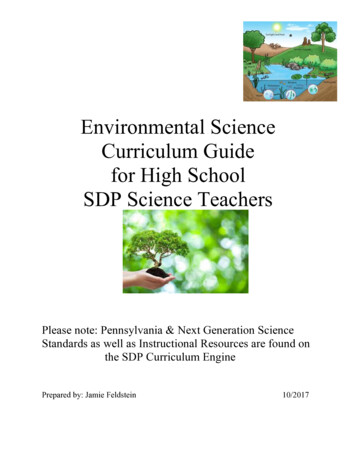
Transcription
Environmental ScienceCurriculum Guidefor High SchoolSDP Science TeachersPlease note: Pennsylvania & Next Generation ScienceStandards as well as Instructional Resources are found onthe SDP Curriculum EnginePrepared by: Jamie Feldstein10/2017
Environmental Science: Term 1 Unit 1Topic: The Scientific Method and Introduction to Environmental ScienceDuration: Traditional (50 minute periods): 8 - 10 classes ( adjust using professionaldiscretion)Block (90 minute periods) : 4 - 5 classes (adjust using professional discretion)Eligible ContentCHEM.A.1.1.2: Classify observations as qualitative and/or quantitative.CHEM.A.1.1.3: Utilize significant figures to communicate the uncertainty in a quantitativeobservation.BIO.B.4.2.4: Describe how ecosystems change in response to natural and human disturbances.BIO.B.3.3.1: Distinguish among the scientific terms: hypothesis, inference, law, theory,principle, fact, and observation.Performance ObjectivesSWBAT: These are examples, created by SDP teachers, of how you may translate the eligiblecontent into learning goals for your classroom. SWBAT to apply the scientific method IOT generate questions about environmentalissues, identify dependent and independent variables, and critique the elements of anexperimental design. SWBAT cite textual evidence IOT draw conclusions regarding human actions andenvironmental impacts. SWBAT proficiently use lab equipment to obtain quantitative data IOT constructgraphical representations and use statistics to interpret and describe experimental results. SWBAT contrast correlation and causation IOT analyze how scientists determine whichfactors impact an environment. SWBAT write a lab report IOT communicate their understanding of the processes andconclusions of the investigation.Key Terms and Definitions1. Causation: when one factor is responsible for the change in another factor.2. Constants: all of the factors that are the same in both the experimental group and the controlgroup.
3. Control: the factor or subject of an experiment that is not manipulated but can be used tomake comparisons between sets of data. The experimental subjects that represent the“normal” conditions.4. Correlation: the mutual relationship between 2 things.5. Dependent variable: the factor in an experiment that is changed or determined bymanipulation of one or more other factors (independent variables), and addresses what isevaluated at the end of the experiment to determine if the experimental and treatment groupsare different.6. Environment: the total of surroundings (air, water, soil, vegetation, people, wildlife)influencing each living being's existence, including physical, biological and all other factors:the surroundings of a plant or animal, including other plants or animals, climate and location.7. Environmental Science: the branch of science concerned with the physical, chemical, andbiological conditions of the environment and their effect on organisms.8. Experimental/treatment group: the experimental subjects that are exposed to the variableof interest.9. Hypothesis: a proposed explanation based on limited observation used as the starting pointof further investigation.10. Independent Variable: the factor in an experiment that is deliberately manipulated, andaddresses what the experiment is designed to test the effect of.11. Law: a concise quantitative statement or equation that proves valid for a wide variety ofphenomena.12. Observation: the process by which scientists learn about their world. Includes looking,noticing and measuring, as well as designing and carrying out experiments and creativelyreevaluating previous observations.13. Qualitative: involves analysis of data such as words (e.g., from interviews and literature),pictures (e.g., video), or objects (e.g., an artifact).14. Quantitative: involves analysis of numerical data (measure, count, etc).15. Sample size: the number of experimental subjects in an experiment (bigger sample size isusually better).16. Scientific Method: a series of steps followed to solve problems including collecting data,formulating a hypothesis, testing the hypothesis, and stating conclusions. A method ofthinking through a problem to a conclusion that is substantiated.17. Scientific Theory: an explanation for some phenomenon that is based on observation,experimentation, and reasoning.18. Theory: a testable explanation for a set of observations.Environmental Science: Term 1 Unit 2Topic: The Basic Chemistry of Our PlanetDuration: Traditional (50 minute periods): 13 - 15 days (adjust using professionaldiscretion)
Block (90 minute periods): 7 - 8 days (adjust using professional discretion)Eligible ContentBIO.A.2.1.1: Describe the unique properties of water and how these properties support life onEarth.BIO.A.2.2.1: Explain how carbon is uniquely suited to form biological macromolecules.BIO.A.2.3.2: Explain how factors such as pH, temperature, and concentration levels can affectenergy.CHEM.A.1.1.1: Classify physical or chemical changes within a system in terms of matter and/orenergy.CHEM.A.1.2.5: Describe how chemical bonding can affect whether a substance dissolves in agiven liquid.Performance ObjectivesSWBAT: These are examples, created by SDP teachers, of how you may translate the eligiblecontent into learning goals for your classroom. SWBAT use the periodic table to diagram the structure of a given atom IOT compareelectron configurations in the first 20 elements. SWBAT distinguish between types of bonds IOT explain how atoms combine to becomemolecules. SWBAT discuss the unique characteristics of the carbon atom IOT identify, draw, anddescribe the function of organic molecules (e.g. recall atomic structure when describingcarbohydrates and hydrocarbons to draw the conclusion that they store potential energy). SWBAT identify reactants and products IOT explain how energy flows through a system(e.g. photosynthesis and respiration, sun and living things). SWBAT diagram and describe water’s structure at the molecular level IOT describe howwater’s unique properties make it essential to all life on Earth and characterize Earth’sinteracting spheres. SWBAT describe how chemistry is the basis for understanding and solvingenvironmental issues IOT create solutions to environmental problems (such as the effectsof acid precipitation in PA).
Key Terms and Definitions1. Acid Precipitation: rain, snow, hail, fog, or dew, with a pH of less than 5.6 due to thepresence of acid pollutants such as sulfuric and nitric acid.2. Acid: a substance with a pH of less than 7 due to a greater amount of free H ions than OHions.3. Adhesion: The intermolecular attraction between unlike molecules. Capillary action resultsfrom the adhesive properties of water and the molecules that make up plant cells.4. Atom: the smallest unit of an element that maintains the properties of that element.5. Base: a substance with a pH of greater than 7 due to a greater about of OH ions than H ions.6. Buffer: a solution that can maintain a nearly constant pH if it is diluted, or if relatively smallamounts of strong acids or bases are added. Buffer solutions resist pH changes7. Carbohydrates: any of various neutral compounds of carbon, hydrogen, and oxygen (assugars, starches, and celluloses) most of which are formed by green plants and whichconstitute a major class of animal foods.8. Cellular Respiration: A complex set of chemical reactions involving an energytransformation where potential chemical energy in the bonds of “food” molecules is releasedand partially captured in the bonds of adenosine triphosphate (ATP) molecules.9. Chemical Change: any change from one state (gas, liquid, solid) which is accompanied byalteration of the chemical composition; any process in which one or more substances arechanged into one or more different substances.10. Cohesion: The intermolecular attraction between like molecules. Surface tension resultsfrom the cohesive properties of water.11. Combustion: a usually rapid chemical process (as oxidation) that produces heat and usuallylight; also a slower oxidation (as in the body).12. Compound: a substance made up of atoms of two or more different elements that arechemically combined.13. Electron: a negatively charged subatomic particle.14. Element: a substance that cannot be separated or broken down into simpler substances bychemical means.15. Energy: usable power that comes from heat, electricity, etc.16. Hydrocarbon: an organic compound (as acetylene or butane) containing only carbon andhydrogen and often occurring in petroleum, natural gas, coal, and bitumens.17. Ion: atoms or molecules that carry either a positive or negative charge as a result of givingaway/gaining electrons.18. Isotope: atoms of the same element that share the same number of protons, but containdifferent amounts of neutrons.19. Matter: the thing that forms physical objects and occupies space.20. Mixture: a combination of two or more substances that are not chemically combined.21. Molecule: the smallest unit of a substance that keeps all of the physical and chemicalproperties of that substance.22. Neutron: a subatomic particle of about the same mass as a proton but without an electriccharge, present in all atomic nuclei except those of ordinary hydrogen.
23. pH: a figure expressing the acidity or alkalinity of a solution on a logarithmic scale on which7 is neutral, lower values are more acid and higher values more alkaline. The pH is equal to log.24. Photosynthesis: A process in which solar radiation is chemically captured by chlorophyllmolecules through a set of controlled chemical reactions resulting in the potential chemicalenergy in the bonds of carbohydrate molecules25. Polarity: a separation of electric charge in a molecule, leading to the ability to interact withwater and other polar molecules, and the inability to interact with nonpolar molecules such asoils.26. Potential Energy: the energy of a body or a system with respect to the position of the bodyor the arrangement of the particles of the system.27. Proton - a stable subatomic particle occurring in all atomic nuclei, with a positive electriccharge equal in magnitude to that of an electron, but of opposite sign.Environmental Science: Term 1 Unit 3Topic: Biogeochemical Cycles, Systems, SpheresDuration: Traditional (50 minute periods): 13 - 15 days (adjust using professionaldiscretion)Block (90 minute periods): 7 - 7 days (adjust using professional discretion)Eligible ContentBIO.B.4.1.2: Describe characteristic biotic and abiotic components of aquatic and terrestrialecosystems.BIO.B.4.2.3: Describe how matter recycles through an ecosystem (i.e. water cycle, carbon cycle,oxygen cycle, nitrogen cycle, etc.).BIO.B.4.2.4: Describe how ecosystems change in response to natural and human disturbances.Performance ObjectivesSWBAT: These are examples, created by SDP teachers, of how you may translate the eligiblecontent into learning goals for your classroom. SWBAT diagram the biogeochemical cycles (i.e. water, carbon, oxygen, nitrogen,phosphorous) IOT explain how the the Law of Conservation of Matter connects bioticand abiotic factors within interlinked systems in the spheres. SWBAT use direct and indirect observations IOT to gather data and draw inferences andconclusions regarding the function of biogeochemical processes.
SWBAT investigate the effects of positive and negative feedback loops in terms of Earthsystems and spheres IOT display how the atmosphere interacts with life on Earth. SWBAT describe the contributions of Earth's four spheres to our planet's life supportsystem IOT analyze how the interactions between the hydrosphere and the biospheresupport life. SWBAT cite evidence-describing ways in which human influences modifybiogeochemical cycles in terms of reservoir storage and fluxesIOT explain howecosystems change in response to human disturbances and propose potential solutions.Key Terms and Definitions1. Atmosphere: the area of air and gas enveloping objects in space, like stars and planets,or the air around any location.2. Abiotic factor: a term that describes a nonliving factor in an ecosystem.*3. Biogeochemical cycles: the movement of abiotic factors between living and nonlinvingcomponents within ecosystems; also known as nutrient cycles (i.e., water cycle, carboncycle, oxygen cycle, and nitrogen cycle).*4. Biosphere: zone of life on Earth; sum total of all ecosystems on Earth.*5. Biotic factor: a term that describes a living or once living organism in an ecosystem.*6. Carbon cycle: the process of carbon atoms being passed between biotic and abioticfactors.7. Cellular respiration: a process by which cells extract energy from organic compoundsby breaking bonds, releasing carbon dioxide as waste products. C6H12O6 6O2 6CO2 6H2O Energy (ATP).8. Consumer: organism that gets its energy by eating other organisms.9. Ecology: study of the relationships between organisms and their interactions with theenvironment.*10. Feedback loop: The section of a control system that allows for feedback and selfcorrection and that adjusts its operation according to differences between the actual andthe desired or optimal output.11. Flux: an operation or series of operations resulting in change.12. Geosphere: any of the almost spherical concentric regions of matter that make up theearth and its atmosphere, as the lithosphere and hydrosphere.13. Greenhouse gas: any of various gaseous compounds (such as carbon dioxide) that absorbinfrared radiation, trap heat in the atmosphere, and contribute to the greenhouse effect.14. Homeostasis: balance15. Hydrologic cycle: the water cycle, how water moves around the earth through biotic andabiotic factors16. Hydrosphere: the water on or surrounding the surface of the globe, including the waterof the oceans and the water in the atmosphere.17. Lithosphere: the rigid outer layer of the earth, having an average thickness of about 75km and comprising the earth's crust and the solid part of the mantle above theasthenosphere.18. Negative feedback loop: a process that returns a system to equilibrium.
19. Nitrogen cycle: the process of nitrogen atoms being passed between biotic and abioticfactors.20. Organism: form of life; an animal, plant fungus, protist or bacterium.*21. Oxygen cycle: the process of oxygen atoms being passed between biotic and abioticfactors.22. Photosynthesis: a process by which solar radiation is chemically captured by chlorophyllmolecule through a set of controlled chemical reactions resulting in the potentialchemical energy in the bonds of carbohydrate molecules 6CO2 6H2O LightEnergy C6H12O6 6O2.*23. Positive feedback loop: a process that amplifies change.24. Producer: organism that makes its own food, an autotroph.25. Reservoir: a supply or source of something. A physical place where a resource is stored.Environmental Science: Term 2 Unit 4Topic: Ecosystem Dynamics: Food Webs, Energy Pyramids, SuccessionDuration: Traditional (50 minute periods): 8 - 11 days (adjust using professional discretion)Block (90 minute periods): 7 - 8 days (adjust using professional discretion)Eligible ContentBIO.B.4.1.1: Describe the levels of ecological organization (i.e., organism, population,community, ecosystem, biome, biosphere).BIO.B.4.1.2: Describe characteristic biotic and abiotic component of aquatic and terrestrialecosystems.BIO.B.4.2.1: Describe how energy flows through an ecosystem (e.g., food chains, food webs,energy pyramids).Performance ObjectivesSWBAT: These are examples, created by SDP teachers, of how you may translate the eligiblecontent into learning goals for your classroom. SWBAT define biotic and abiotic limiting factors IOT give examples of each anddescribe their interactions. SWBAT diagram the trophic levels in food chains and food webs IOT explain howenergy moves through an ecosystem. SWBAT relate limiting factors to primary productivity IOT calculate the productivity ofecosystems. SWBAT trace the path of energy from the sun through trophic levels IOT describe whyprimary productivity is the basis of the food chain.
SWBAT classify organisms according to their position in a food chain IOT identifyconsumers, herbivores, carnivores, omnivores and detritivores. SWBAT define succession, list 2 types of ecological succession, and know theimportance of lichens IOT analyze how nutrient cycling is demonstrated in old fieldsuccession and primary succession.Key Terms and Definitions1. Organism - form of life, an animal, plant, fungus, protist or bacterium2. Population - group of individuals of the same species living in a specific geographicalarea and reproducing3. Community (ecological) - different populations of organisms interacting in a sharedenvironment4. Ecosystem - a system composed of organisms and nonliving components for anenvironment5. Ecology - study of the relationships between organisms and their interactions with theenvironment6. Abiotic factor - a term that describes a nonliving factor in an ecosystem7. Biotic factor - a term that describes a living or once-living organism in an ecosystem8. Consumer (ecological) - organism that obtains energy by feeding on other organisms ortheir remains9. Decomposer - an organism that obtains nutrients by consuming dead and decayingorganic matter which allows nutrients to be accessible to other organisms10. Bioenergetics - the study of energy flow (energy transformations) into and within livingsystems11. Autotroph - an organism that can synthesize its food from inorganic substances usingheat or light as a source of energy12. Carnivore - an organism that derives its energy and nutrient requirements froma diet consisting mainly or exclusively of animal tissue, whether throughpredation or scavenging.13. Detritivore - an organism that feeds on detritus (“trash”, “dead things”, organic orinorganic matter); a saprophage14. Ecology - is the scientific analysis and study of interactions among organisms and theirenvironment15. Ecosystem - an interacting group of living organisms in an area16. Herbivore - animals that eat plants17. Heterotroph - an organism which requires an external supply of energy in the formof food because it cannot make its own18. Omnivore - An animal which is able to consume both plants (like a herbivore)and meat (like a carnivore).19. Producer (ecological) an organism that uses a primary energy source to conductphotosynthesis or chemosynthesis
20. Limiting factor - chemical, physical, or biological factor that limits the existence,growth, abundance, or distribution of an individual organism or a population21. Biomass - is the mass of living biological organisms in a given area or ecosystem at agiven time.22. Food chain - a simplified path illustrating the passing of potential energy (food) fromone organism to another organism23. Food web - a complex arrangement of interrelated food chains illustrating the flow ofenergy between interdependent organisms24. Keystone species - a species that has a disproportionately large effect on its environmentrelative to its abundance.25. Primary producer - organisms that make their own food from sunlight and/or chemicalenergy from deep sea vents; are the base of every food chain; these organisms are calledautotrophs.26. Primary productivity -the rate of generation of biomass in an ecosystem.27. Energy pyramid - a model that illustrates the biomass productivity at multiple trophiclevels in a given ecosystem.28. Secondary consumer - a carnivore that preys upon herbivores29. Trophic level - the position of an organism in relation to the flow of energy andinorganic nutrients through an ecosystem (e.g., producer, consumer, and decomposer)30. Succession - a series of predictable and orderly changes within an ecosystem over time31. Primary succession - change that occurs on surface where no ecosystem was before, likeon rocks or on sand32. Secondary succession - change that occurs on a surface where an ecosystem alreadyexisted33. Pioneer species - the first organism to colonize any new area34. Climax community - final, stable community35. Environmental science - the science of the interactions between the physical, chemical,and biological components of the environment.36. Environmentalism - a broad philosophy, ideology and social movement regardingconcerns for environmental protection and improvement of the health of the environment,particularly as the measure for this health seeks to incorporate the concerns of non-humanelements37. Natural resource - any of the materials derived from the environment38. Renewable resource - a naturally occurring raw material or form of energy that will bereplenished through natural ecological cycles or sound management practices39. Nonrenewable resource - substances (e.g., oil, gas, coal, copper, gold) that once usedcannot be replaced in this geological age40. Sustainable - a naturally occurring raw material or form of energy that will bereplenished through natural ecological cycles or sound management practices (e.g., thesun, wind, water, trees).Environmental Science: Term 2 Unit 5Topic: Evolution & Biodiversity
Duration: Traditional (50 minute periods) : 18 -21 days (adjust to student needs usingprofessional discretion)Block(90 minute periods) : 8-9 days (adjust to student needs usingprofessional discretion)Eligible ContentBIO.B.4.1.1: Describe the levels of ecological organization (i.e., organism, population,community, ecosystem, biome, biosphere).BIO.B.4.2.4: Describe how ecosystems change in response to natural and human disturbances(introduction of nonnative species).BIO.B.4.2.5: Describe the effects of limiting factors on population dynamics and potentialspecies extinction.Performance ObjectivesSWBAT: These are examples, created by SDP teachers, of how you may translate the eligiblecontent into learning goals for your classroom. SWBAT explain evolution by natural selection IOT analyze the role of the environmentin ecosystem change. SWBAT describe artificial selection IOT compare natural selection and artificialselection and understand the human influence on each process. SWBAT explain the process of speciation and how speciation and extinction affectbiodiversity IOT understand and explain the role of evolution in biodiversity. SWBAT Describe how to map and monitor biodiversity and current global trends inbiodiversity IOT explain global trends of ecosystem health and problems over short termand geologic time. SWBAT compare and contrast endangered and threatened species using Pennsylvaniaexamples and identify the risks to biodiversity IOT develop strategies to protectbiodiversity.Key Terms and Definitions1. Adaptation - Adjustment to extant conditions: as, adjustment of a sense organ to theintensity or quality of stimulation; modification of some thing or its parts that makes itmore fit for existence under the conditions of its current environment.2. Artificial selection - because people (instead of nature) select which organisms get toreproduce.
3. Biodiversity - is the variety of different types of life found on earth. It is a measure of thevariety of organisms present in different ecosystems.4. Competition * - When individuals or groups of organisms compete for similar resourcessuch as territory, mates, water, and food in the same environment.5. Ecosystem diversity - It is the variation in the ecosystems found in a region or thevariation in ecosystems over the whole planet.6. Endangered species - A species that is in danger of extinction throughout all or asignificant portion of its range.7. Endemic - the ecological state of a species being unique to a defined geographic location,such as an island, nation, country or other defined zone, or habitat type; organisms thatare indigenous to a place are not endemic to it if they are also found elsewhere.8. Evolution *– a process in which new species develop from preexisting species(biological evolution or macroevolution); a change in the allele frequencies of apopulation of organisms from generation to generation (genetic evolution ormicroevolution).9. Extinction * - A term that typically describes a species that no longer has any knownliving individuals.10. Extirpation - is the condition of a species (or other taxon) that ceases to exist in thechosen geographic area of study, though it still exists elsewhere.11. Fossils *- The preserved remains or traces of organisms that once lived on Earth.12. Founder Effect * - A decrease in genetic variation caused by the formation of a newpopulation by a small number of individuals from a larger population.13. Gene pool - is the set of all genes, or genetic information, in any population.14. Genetic diversity - refers to the total number of genetic characteristics in the geneticmakeup of a species.15. Genetic drift *- A change in the allele frequency of a population as a result of chanceevents rather than natural selection.16. Habitat * - An area that provides an organism with its basic needs for survival.17. Habitat fragmentation - describes the emergence of discontinuities (fragmentation) inan organism's preferred environment.18. Homologous Structure * - A physical characteristic in different organisms that is similarbecause it was inherited from a common ancestor.19. Inheritance * - The process in which genetic material is passed from parents to theiroffspring.20. Invasive species - is a plant or animal that is not native to a specific location (an introducedspecies); and has a tendency to spread, which is believed to cause damage to theenvironment, human economy and/or human health.21. Mass extinction - is a widespread and rapid decrease in the amount of life on Earth.22. Mutation *- is a permanent change of the nucleotide sequence of the genome of anorganism, virus, or extrachromosomal DNA or other genetic elements.23. Natural selection * - A process in nature in which organisms possessing certain inheritedtraits are better able to survive and reproduce compared to others of their species.24. Nonnative Species * - A species typically living outside a distribution range that hasbeen introduced through either deliberate or accidental human activity; also known asintroduced, alien, nonindigenous, or exotic species.25. Organism * - A form of life; an animal, plant, fungus, protist or bacterium.
26. Population * - A group of individuals of the same species living in a specificgeographical area and reproducing.27. Poaching - has traditionally been defined as the illegal hunting, killing, or capturing ofwild animals, usually associated with land use rights.28. Speciation * - A process typically caused by the genetic isolation from a main populationresulting in a new genetically distinct species.29. Species * - the lowest taxonomic level of biological classification consisting oforganisms capable of reproduction that results in fertile offspring.30. Species diversity - the number of different species that are represented in a givencommunity.31. Taxonomical key - classify organisms based on their relationship to other organisms.32. Vestigial structure * - A physical characteristic in organisms that appears to have lost itsoriginal function as a species has changed over time.33. Variation - is the raw material of evolution. Without genetic variation, a populationcannot evolve in response to changing environmental variables and, as a result, may facean increased risk of extinction.Environmental Science: Term 2 Unit 6Topic: Biomes (Terrestrial & Aquatic)Duration: Traditional (50 minute periods) : 18 -21 days (adjust to student needs usingprofessional discretion)Block(90 minute periods) : 8-9 days (adjust to student needs usingprofessional discretion)Eligible ContentBIO.B.4.1.1 Describe the levels of ecological organization (ie. organisms, population,community, ecosystem, biome, biosphere).BIO.B.4.1.2 Describe characteristic biotic and abiotic component of aquatic and terrestrialecosystems.BIO.B.4.2.4 Describe how ecosystems change in response to natural and human disturbances(e.g. climate changes, introduction of nonnative species, pollution, fires).Performance ObjectivesSWBAT: These are examples, created by SDP teachers, of how you may translate the eligiblecontent into learning goals for your classroom. SWBAT model the effect the tilt of the Earth has on the uneven heating of the surfaceIOT explain the reason for the seasons.
SWBAT interpret climatographs or a diagram of temperature and precipitation withregard to the worlds’ biomes IOT draw conclusions about their importance indetermining the characteristics of biomes. SWBAT describe the latitude and altitude of the worlds’ terrestrial biomes IOT explainhow they determine the plant community in each biome. SWBAT describe 4 plant and 4 animal species in 2 different biomes IOT distinguishthose biomes from each other. SWBAT research the relationship between specific organisms and their biomes IOT mapfood chains in the biome and analyze how adaptations help them survive in thatenvironment. SWBAT use real-world data and field observations IOT determine in which biome theylive. SWBAT cite textual evidence regarding invasive aquatic species IOT explain howecosystems change in response to natural and human disturbances.Key Terms and Definitions1. Biome - a large area or geographical region with distinct plant and animal groups adaptedto that environment2. Biosphere - the zone of life on Earth; sum total of all ecosystems on Earth (all biomesare included in this)3. Abiotic factor - a term that describes a nonliving factor in an ecosystem4. Biotic factor - a term that describes a living or once-living organism in an ecosystem5. Habitat - an area that provides an organism with its basic need for survival (found withinbiomes)6. Ecosystem - a system composed of organisms and nonliving components of anenvironment7. Climate - change is a change in the statistical distribution of weather patterns when thatchange lasts for an extended period of time.8. Latitude - distance north or south of e
Key Terms and Definitions 1. Acid Precipitation: rain, snow, hail, fog, or dew, with a pH of less than 5.6 due to the presence of acid pollutants such as sulfuric and nitric acid. 2. Acid: a substance with a pH of less than 7 due to a greater amount of free H ions than OH ions. 3. Adhesion: The intermolecular attraction between unlike molecules. Capillary action re

